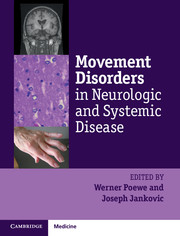Book contents
- Frontmatter
- Contents
- List of contributors
- List of videos
- List of abbreviations
- Preface
- Section I General principles
- Section II Movement disorders in systemic disease
- Section III Iatrogenic and toxic movement disorders
- Section IV Movement disorders in general neurology
- Section V Systemic complications of movement disorders
- Chapter 24 Dysautonomia in movement disorders
- Chapter 25 Gastrointestinal complications of movement disorders
- Chapter 26 Respiratory complications of movement disorders
- Chapter 27 Movement disorders emergencies
- Index
- Plate Section
- References
Chapter 27 - Movement disorders emergencies
from Section V - Systemic complications of movement disorders
Published online by Cambridge University Press: 05 April 2014
- Frontmatter
- Contents
- List of contributors
- List of videos
- List of abbreviations
- Preface
- Section I General principles
- Section II Movement disorders in systemic disease
- Section III Iatrogenic and toxic movement disorders
- Section IV Movement disorders in general neurology
- Section V Systemic complications of movement disorders
- Chapter 24 Dysautonomia in movement disorders
- Chapter 25 Gastrointestinal complications of movement disorders
- Chapter 26 Respiratory complications of movement disorders
- Chapter 27 Movement disorders emergencies
- Index
- Plate Section
- References
Summary
Introduction
A movement disorder emergency is defined as any movement disorder that evolves or clinically worsens over hours to days. It can occur with hypokinetic as well as hyperkinetic conditions. The systemic and neurological sequelae can originate from the inherent disease process, excessive movements, or a combination of both. Failure to recognize and efficiently manage these patients carries a significant risk of morbidity and mortality.
We review the six major categories of movement disorder emergencies: parkinsonism, dystonia, chorea, myoclonus, tics, and emergencies associated with deep brain stimulation.
Acute parkinsonism
Acute parkinsonism, or non-neurodegenerative parkinsonism, develops suddenly over hours to days. Unlike idiopathic Parkinson’s disease (PD), symptoms are usually symmetric, with prominent bradykinesia and rigidity. Dopamine-blocking medications are the most common precipitants. Consideration of rarer etiologies such as toxins and chemotherapy, structural lesions, and rapid dystonia-parkinsonism, viral encephalitis, and neuroleptic malignant syndrome is predicated in the clinical context (Table 27.1).
Drug-induced parkinsonism
Drug-induced parkinsonism (DIP) is commonly caused by medications that affect dopamine efficacy either by blocking its receptors or depleting its stores (i.e. neuroleptics, antiemetics). As many as 60 percent of patients develop symptoms within one month of initiating these medications, and 90 percent by the third month (Quinn 1995). Its incidence increases with age and it tends to have a bimodal distribution, with an initial peak in adolescence and a second peak after the sixth decade (Susatia and Fernandez 2009). Women are twice as likely as men to be affected, and the risk of developing it correlates with the potency of the drug (Ayd 1961).
- Type
- Chapter
- Information
- Movement Disorders in Neurologic and Systemic Disease , pp. 419 - 441Publisher: Cambridge University PressPrint publication year: 2014

